This English Hang Lexicon offers short explanations about keywords regarding the Hang versions from 2001 to 2009. Information about the Free Integral Hang and PANArt’s new Pang instruments are only in the extended German version.
Brass
The Second Generation Hang has a coating made of brass. It was applied with a brass brush and annealed onto the outer surface in a kiln. This procedure was abandoned for the Integral Hang. Only the Ding dome of the Integral Hang has a brass coating. Another sign of Hanghang built starting in 2006 is the added brass ring around the seam between the upper and lower halves of the Hang. 

Corrosion Protection
The Nitriding process creates a micro thin layer that helps prevent oxidation (rust) of the steel. Until 2008 a thin layer of Biofa Hard Oil was also applied with a cloth as a final step in the creation of the Hang. Since 2009 PANArt uses a new cleaning and anticorrosion fluid based on biopolymers. (More…)
Development Stages
The following figure shows the development stages of the Hang from 2000 to 2010. Klick on the elements of the figure for more information.
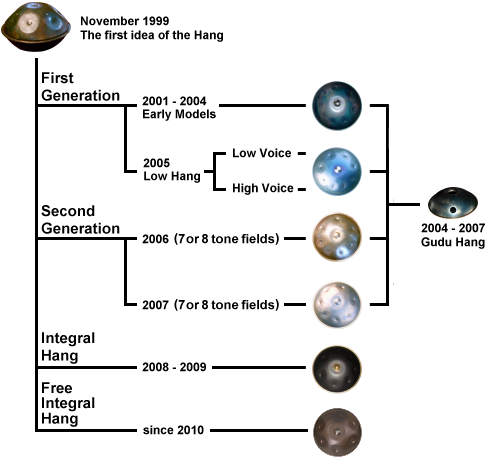
Ding
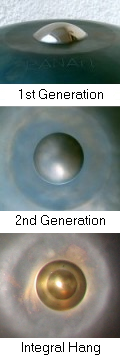 The central domed note on top of the Hang. This is the lowest note on the instrument. It corresponds with the Helmholtz Resonance of the air inside the Hang. The Ding note is played by striking either the dome or the flattened area around the dome. The upper half shell of the Hang is also referred to as the ‘Ding side’.
The central domed note on top of the Hang. This is the lowest note on the instrument. It corresponds with the Helmholtz Resonance of the air inside the Hang. The Ding note is played by striking either the dome or the flattened area around the dome. The upper half shell of the Hang is also referred to as the ‘Ding side’.
The First Generation Hanghang had a Ding between Eb3 and Bb3 (for the early models usually A3 and G3, the Low Hang from 2005 mainly F3). With increasing experience Hang Makers were able to get the Ding note of the Hang lower and lower. Almost all of the Second Generation Hanghang have a D3 tuned Ding. While the First Generation Hanghang had a shiny polished Ding, the Second Generation Hanghang of 2006 and 2007 had a surface coating of annealed brass.
While the 2008 Integral Hang is tuned to D3 as was the Ding of the models from 2006 and 2007 it has a several significant alterations. There is a circular segmentation in the dome creating a “dome within a dome“. It also has a significant amount of brass brushed on, annealed, and then laquered creating a rougher surface than the Ding of the previous models. Also the flattened tone field around the Ding dome no longer has a distinct border, it fades gently into the transitionary curved shoulder of the Hang. 
Du
See Gudu Hang. 
Dum
A small flared tube made from turned pear wood offered by PANArt. It can be placed in the Gu opening of First Generation or Second Generation Hanghang to lower the Helmholtz resonance a fifth by narrowing and extending the neck of the Gu. 
First Generation
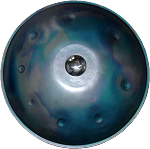 One name often used to describe the Hanghang made prior to the end of 2005. It is based on statements made by the Hang Makers when they announced the evolution of the Hanghang in the spring of 2006 referring to them as the “New Generation” of the Hang. ( Photos…
One name often used to describe the Hanghang made prior to the end of 2005. It is based on statements made by the Hang Makers when they announced the evolution of the Hanghang in the spring of 2006 referring to them as the “New Generation” of the Hang. ( Photos…  )
) 
Gu
The round resonating opening in the middle of the lower half shell of the Hang, opposite the ‘Ding Side’. This ‘bottom’ of the Hang is also referred to as the ‘Gu Side’. The Gu opening combined with the air volume in the body of the Hang act as a Helmholtz resonator. Helmholtz Resonance can be generated by striking the Ding or by slapping the opening of the Gu directly with the flat of the hand.

In the First Generation the rim and inside neck of the Gu was polished, the Second Generation are not polished. The Integral Hang (2008) has a Gu which has been shaped slightly towards an oval. Since 2007 the rim of the Gu hole (Gu-Ring) has been specifically tuned: Two close tones of F5 and F#5 open new possibilities and when played together make a vibratory ringing note. 
Gudu Hang
This version of the Hang has a second opening (Du) on the bottom to the side of the center Gu. Udu like effects can be generated using them both. When the Du opening is not used it can be covered with an included flexible magnetic disc. The Gudu Hang was available on models made from 2004 through 2007. 

Hang
The name of the instrument is based on the fact that it is played with the hands: Hang means ‘hand’ in the Bernese dialect. The term Hang is a registered trademark of PANArt Hangbau AG in many countries. It isn’t allowed to use this name for other musical instruments or services like arranging of events, publications etc.. (More…) 
Hangbauhaus
This is what the Hang Makers called their workshop from 2006 to 2010. 
Hang Drum
This term was first used in 2002 by Lark in the morning, a musical instrument dealer, who at that time sold the Hang in the U.S.A. This new name was one of the reasons why PANArt decided to terminate business relations with this distributor. Once set in use, the term spread quickly, mostly in the English speaking regions and on the Internet. The combination of Hang with another term made it easier for it to be found in search engines or on YouTube. (More…)
Hanghang
This reduplication is used by the Hang Makers as the plural form of Hang: one Hang, several Hanghang. 
Hanghaus
A wooden house on the bank of the Aare, which previously served as a workshop for PANArt. Later it served as a presentation space for the finished Hanghang where those interested chose their instrument. Today it has various functions. 
Helmholtz Resonance
The phenomenon of air resonance in a cavity. An example of Helmholtz resonance is the sound created when one blows across the top of an empty bottle. The interior of the Hang in conjunction with the Gu hole creates a Helmholtz resonator. The frequency with which the air in this system oscillates is based on both the air volume inside the Hang and by diameter and length of the neck of Gu. If the Gu is unobstructed it resonates at F2 with the Ding if it is set to an F3. This gives the Hang a deep fundamental and a strong harmonic resonance to the whole instrument. Even when a Hang has a Ding lower than F3 the bass tone can be brought into resonance with the Ding. If the Hang is set horizontally on the lap the bass can be adjusted by reducing the angle of the legs as until it is exactly one octave below the Ding. With the Hang held in the vertical position the resonant relationship can be achieved by covering the Gu slightly with one hand. The Helmholtz resonance can be set into motion through a damped blow to the Ding, by slapping the Gu with the flat of the hand or by striking the Hang at the ‘shoulder’ between the flat of the Ding Tone Field and the Tone Fields in the Tone Circle with the heel of hand. 
High Voice
See Low Voice. 
Integral Hang
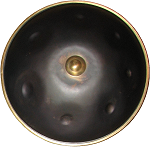 In February of 2008 PANArt announced a further development in their instrument journey: The Integral Hang. The surface of the new instruments is darker than the Second Generation. Also the design of the Ding has been changed. While the overall shape of the upper side is similar to the 2007 Hang, the Gu-opening of the Integral Hang has been slightly ovaled. The positioning of the diagonal Tone Fields in the Tone Circle and the brass ring at the seams connecting the two half shells remains consistent from the 2007 model Hanghang. With the Integral Hang, the Hang Makers appear to have reached a natural conclusion to the reduction of Sound Models over the years in their attempts at finding the best overall sound quality of the instrument as well as the best interplay of the tone fields. The Integral Hang has only one Sound Model: D3 Ding with seven notes A3, Bb3, C4, D4, E4, F4, and A4 surrounding it in the Tone Circle.
In February of 2008 PANArt announced a further development in their instrument journey: The Integral Hang. The surface of the new instruments is darker than the Second Generation. Also the design of the Ding has been changed. While the overall shape of the upper side is similar to the 2007 Hang, the Gu-opening of the Integral Hang has been slightly ovaled. The positioning of the diagonal Tone Fields in the Tone Circle and the brass ring at the seams connecting the two half shells remains consistent from the 2007 model Hanghang. With the Integral Hang, the Hang Makers appear to have reached a natural conclusion to the reduction of Sound Models over the years in their attempts at finding the best overall sound quality of the instrument as well as the best interplay of the tone fields. The Integral Hang has only one Sound Model: D3 Ding with seven notes A3, Bb3, C4, D4, E4, F4, and A4 surrounding it in the Tone Circle. 
Low Hang
 PANArt called the instruments built in the year 2005 Low Hang because they focussed more and more on deeper sound models. The Low Hang resembles the Hanghang of the previous years an is therefore also assigned to the First Generation. It has a Ding in F3, E3 or Eb3 and is tuned in two types of sound models: the high voice with eight tone fields and the low voice with seven tone fields in the circle. (Photos…
PANArt called the instruments built in the year 2005 Low Hang because they focussed more and more on deeper sound models. The Low Hang resembles the Hanghang of the previous years an is therefore also assigned to the First Generation. It has a Ding in F3, E3 or Eb3 and is tuned in two types of sound models: the high voice with eight tone fields and the low voice with seven tone fields in the circle. (Photos…  )
) 
Low Voice
In the first four years, PANArt offered Hang Sound Models with eight notes in Tone Circle. For the Low Hang in 2005 they introduced also Sound Models with only seven notes in the Tone Circle. The Sound Models with eight notes were called High Voice, while those with seven notes were called Low Voice. 
Overtones
 Each Tone Field (and the Ding) is tuned with the fundamental frequency and two overtones: the octave and the compound fifth (a fifth above the octave). Tone fields have the octave stressed when striking the short side, while on the long side the compound fifth is generated. (More…)
Each Tone Field (and the Ding) is tuned with the fundamental frequency and two overtones: the octave and the compound fifth (a fifth above the octave). Tone fields have the octave stressed when striking the short side, while on the long side the compound fifth is generated. (More…) 
PANArt Hang Manufacturing Ltd.
This is the company of the Hang Makers Felix Rohner and Sabina Schärer. It was initially PANArt Steelpan Manufacturing Ltd. At the end of 2003 a few years after the Hang Makers started devoting all of their time to the production and development of the Hang they renamed the company PANArt Hang Manufacturing Ltd. (original: PANArt Hangbau AG). According to the Swiss commercial register the company’s purpose is “development, manufacture and distribution of musical instruments, their accessories and of sound sculptures as well as additional activities in fostering of new music forms”. (More…)
PANArt’s Website
 In spring 2002, as the Hang Makers began to focus more completely on development and manufacture of the Hang, they closed down their prior homepage www.panart.ch as well as the information on the PANG Steel Pan development and instruments. Instead, a new website was published – www.hang.ch. It had information about the Hang as an instrument, listed the Sound Models, as well as the distributors in various countries. In winter 2005/2006 along with the development of the Second Generation Hang, and the termination of the dealer network PANArt decided that the Hang was no longer be offered via the internet. All the information except the contact details of the PANArt was removed from the site. In summer 2006 www.hang.ch was completely shut down.
In spring 2002, as the Hang Makers began to focus more completely on development and manufacture of the Hang, they closed down their prior homepage www.panart.ch as well as the information on the PANG Steel Pan development and instruments. Instead, a new website was published – www.hang.ch. It had information about the Hang as an instrument, listed the Sound Models, as well as the distributors in various countries. In winter 2005/2006 along with the development of the Second Generation Hang, and the termination of the dealer network PANArt decided that the Hang was no longer be offered via the internet. All the information except the contact details of the PANArt was removed from the site. In summer 2006 www.hang.ch was completely shut down.
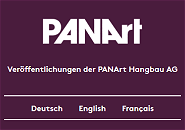 Until 2013 PANArt Hang Manufacturing Ltd. didn’t run an own website. During this time publications by PANArt were released in the Hang Library. Since summer 2013 the company has been present on the Internet again at www.gubal.ch and www.hang.ch and since September 2015 at panart.ch
Until 2013 PANArt Hang Manufacturing Ltd. didn’t run an own website. During this time publications by PANArt were released in the Hang Library. Since summer 2013 the company has been present on the Internet again at www.gubal.ch and www.hang.ch and since September 2015 at panart.ch  .
.
Sales
Starting in 2001 PANArt built an international dealer network, which by 2005 had several shops in Switzerland and one distributor in each of the following areas: Australia, Austria, Canada, England, France, Germany, Israel, Italy, Japan, the Netherlands, Sweden, Spain and the United States. Because they were no longer capable of addressing the increased demand PANArt stopped sales through the dealer network in early 2006. Since then, Hanghang were only available directly from PANArt in Bern.
In 2006 and 2007 buyers needed to obtain an appointment at the Hangbauhaus in Bern to purchase a Hang. Since the announcement of the single model Integral Hang in February 2008 shipping became an option again. Beginning with the sale of the Free Integral Hang in spring 2010, the practice of shipping instruments to customers was discontinued. There was still the requirement to write to PANArt and often a significant wait to obtain a purchase opportunity as the demand remained high. Since the beginning of 2014 the Hang is no longer offered. (More…) 
Scales
See Sound Models. 
Second Generation (New Generation)
 A term used to refer to Hanghang built from 2006 through 2007. It is based on statements by the Hang Makers in announcements regarding the evolution of the Hang in the spring of 2006. They mentioned a “new generation” of the Hang had been made. In these instruments, the two half-shells sport a coating of annealed brass. Also at the seam where the two shells meet there is a brass ring. Furthermore the Hang Makers changed the basic approach to Sound Models with the Second Generation Hanghang. Most Hanghang of the new generation had 7 tones in the Tone Circle. The Tone Fields in the circle of the instruments from 2007 were shifted to a 45° angle to the radius of the Hang. The successor of the Second Generation is the Integral Hang. (Photos…
A term used to refer to Hanghang built from 2006 through 2007. It is based on statements by the Hang Makers in announcements regarding the evolution of the Hang in the spring of 2006. They mentioned a “new generation” of the Hang had been made. In these instruments, the two half-shells sport a coating of annealed brass. Also at the seam where the two shells meet there is a brass ring. Furthermore the Hang Makers changed the basic approach to Sound Models with the Second Generation Hanghang. Most Hanghang of the new generation had 7 tones in the Tone Circle. The Tone Fields in the circle of the instruments from 2007 were shifted to a 45° angle to the radius of the Hang. The successor of the Second Generation is the Integral Hang. (Photos…  )
) 
Serial Number
Every Hang has an individual serial number. First generation Hanghang had a small white piece of paper pasted inside the Hang which was visible through the Gu. On it was also written the name of the Sound Model and the signature of Sabina Schärer or Felix Rohner. The numbers went up to about 4300.

Second Generation Hanghang had the serial number engraved into the inside edge of the hole in the Gu side. They had a prefix of N. and went from N.0001 to N.0826. The Integral Hang shifted all the information that was on the Hang to the Gu side outside edge. There the PANArt Logo, the signatures of both the makers, date of finalization, and the restarted serial number are written. The serial numbers began again with 1 and now have an H in front of the number (H45 for example). 
Signature
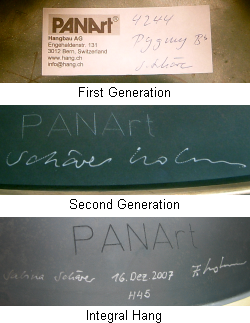 The First Generation Hang had a sticker with a handwritten Serial Number and Sound Model name along with a signature of one of the Hang Makers. The Second Generation instruments have a signature engraved on the edge of the bottom of the Hang (“Rohner Schärer” or “Schärer Rohner”). The Integral Hang has the production date and serial number engraved in the same location. The spelling of signatures has been changed (“Sabina Schärer” and “F. Rohner”).
The First Generation Hang had a sticker with a handwritten Serial Number and Sound Model name along with a signature of one of the Hang Makers. The Second Generation instruments have a signature engraved on the edge of the bottom of the Hang (“Rohner Schärer” or “Schärer Rohner”). The Integral Hang has the production date and serial number engraved in the same location. The spelling of signatures has been changed (“Sabina Schärer” and “F. Rohner”). 
Sound Models
Because the Tone Fields on the Hang are limited in number, the Hang Makers felt the need to leave behind the traditional Steel Pan chromatic scales and to find new paths forward. Initially they chose an ethnomusicological approach utilizing many different scales from different cultures for the sound of the Hanghang. As the musical possibilities of Hanghang are not only based on the scale used, they chose to refer to the Hang in terms of “Sound Models”. A Sound Model is defined by the frequency of the Ding, the number of Tone Fields in Tone Circle and scale used.
In the first few years they offered 30 different Sound Models. All had 8 notes in the Tone Circle. A3 Dings and G3 Dings numbered fourteen Sound Models each, and there were two with F3 Dings. In 2004 they offered 45 Sound Models and modified some of the prior scales. The sound of the Dings shifted toward the lower tones (1 x Bb3, 13 x A3, 19 x G3, 12 x F3).
In 2005 the Sound Models offered with the Low Hang were completely changed. Only 14 sound models were newly made all with a F3-Ding in both a High Voice Hang with 8 notes, and Low Voice Hang with 7 notes in the Tone Circle. The older models and custom models were still available on request.
In 2006 the Hang Makers chose a whole new conceptual approach for the Second Generation of the Hanghang. They began with the Helmholtz resonance of the body which can be brought to a responsive D2 with the proper adjustment of the legs or with the hands. The Ding was set to D3. A3 was the lowest note in the Tone Circle and the octaves of these two notes, D4 and A4 were in the circle as well. Almost all Second Generation Hanghang are built with this basic structure. The other notes are chosen by the tuner based on each instrument according to artistic discretion. Second Generation models are predominantly configured with seven notes in the tone circle.
As time passed PANArt found that there were certain Sound Models that had better overall resonance so they continued to reduce their number in 2007. The Integral Hang (2008) then only was one model and one set of notes: D3 Ding with a Tone Circle consisting of A3, Bb3, C4, D4, E4, F4 and A4. (More…) 
Sunlight
Direct sunlight on the Hang from a cloudless sky, especially on or near the Ding, can quickly heat the Steel to high temperatures. This leads to a temporary de-tuning and dampening of the Hang’s tones, which resolve after the Hang cools. 
Tone Circle
Around the central Ding tone there is a Tone Circle of eight or seven Tone Fields. Among the instruments of the First Generation (2001 to 2005) and the first Hanghang of the Second Generation in 2006 there were radially oriented Tone Fields. From 2007 the Tone Fields were shifted to a 45° angle to the radius of the Hang. The changed orientation improves the radiation of the tones and gives a clearer sound. The illustrations show the sequence of tones from the lowest (No.1) to the highest tone (No. 7 or No. 8). 
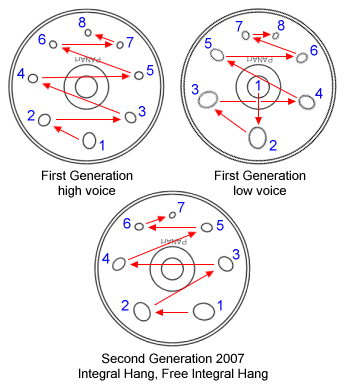
Tuning
With both the Steel Pan and the Hang, the term ‘Tuning’ has multiple implications. This can refer to ‘tuning’ of an instrument or of a tone field that is no longer in tune. But, more often, it is a term for the entire process of creating the instrument and how the hammers set the notes into the steel. Detailed information about the tuning of the Hang is in History, Developement and Tuning of the HANG by Felix Rohner and Sabina Schärer. 
